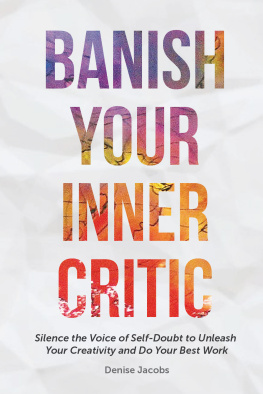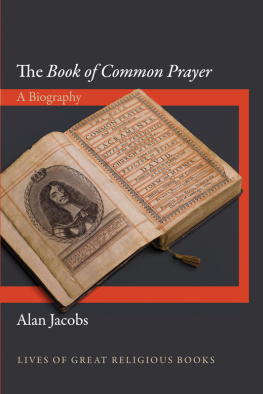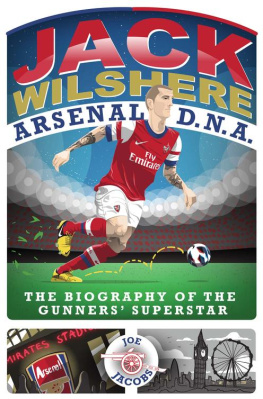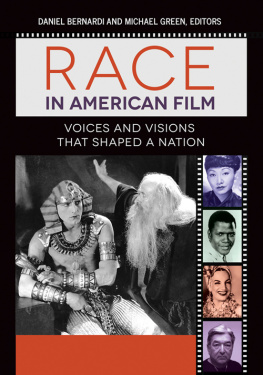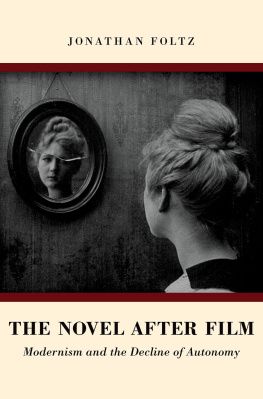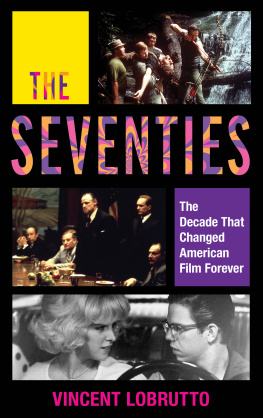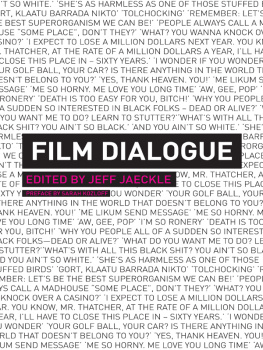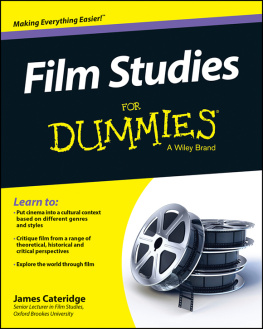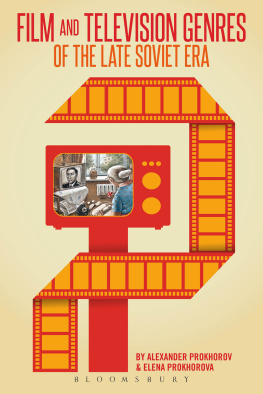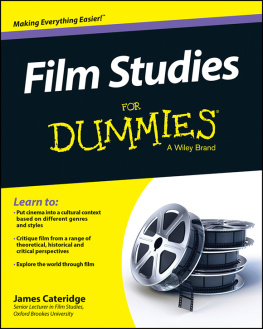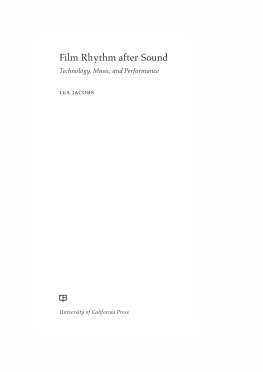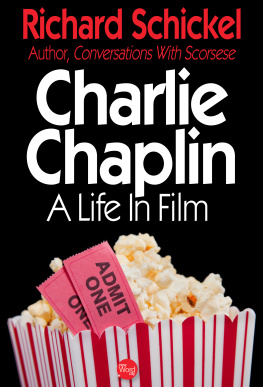The publisher gratefully acknowledges the generous contribution to this book provided by the Simpson Humanities Endowment Fund of the University of California Press Foundation.
The Decline of Sentiment
American Film in the 1920s
LEA JACOBS

University of California Press, one of the most distinguished university presses in the United States, enriches lives around the world by advancing scholarship in the humanities, social sciences, and natural sciences. Its activities are supported by the UC Press Foundation and by philanthropic contributions from individuals and institutions. For more information, visit www.ucpress.edu .
Parts of this book were previously published in different form as The Seduction Plot: Comic and Dramatic Variants, Film History 13, no. 4 (2001): 42442, and Men without Women: The Avatars of What Price Glory, Film History 17, nos. 23 (2005): 30733, and are reprinted here by permission of Indiana University Press.
University of California Press
Berkeley and Los Angeles, California
University of California Press, Ltd.
London, England
2008 by The Regents of the University of California
Library of Congress Cataloging-in-Publication Data
Jacobs, Lea.
The decline of sentiment : American film in the 1920s / Lea Jacobs.
p. cm.
Includes bibliographical references and index.
ISBN 978-0-520-23701-8 (cloth : alk. paper)
ISBN 978-0-520-25457-2 (pbk. : alk. paper)
1. Motion picturesUnited StatesHistory. 2. Silent films
United StatesHistory. 3. Melodrama in motion pictures. I. Title.
PN1993.5.U6J198 2008
791.43'75dc22
2007025657
Manufactured in the United States of America
17 16 15 14 13 12 11 10 09 08
10 9 8 7 6 5 4 3 2 1
The paper used in this publication meets the minimum requirements of ANSI/NISO Z39.481992 (R 1997) (Permanence of Paper).
To Ben
Preface
For anyone who enjoys even a cursory familiarity with American film of the 1930s and 1940s, with How Green Was My Valley or Going My Way or The Little Colonel, the idea that sentiment declined in the 1920s may seem implausible. But this book does not maintain that Hollywood ceased to produce films that might be considered moving or, by some, excessively pathetic. Rather, it seeks to delineate the moment when journalists and reviewers first began to criticize films on the grounds that they were cloying, foolishly optimistic, or too intent on achieving big dramatic effects. It argues that the rejection of sentimentality was a relatively new phenomenon within the American cinema of the period following World War I, although such a position already had currency in elite literary circles.
This work is proposed as a history of taste. While there are precedents for it in art history, I do not know of any in the field of film studies. I should make clear, therefore, that this investigation does not encompass the film spectator as such. I do not attempt to document the vagaries and eccentricities of individual viewing preferences, fascinating though these can sometimes be, nor do I embark upon a more properly sociological account of taste considered as the aggregate of individual preferences. Insofar as taste can be said to have a history, it seems to me to consist in the systematic alteration or, more conservatively, preservation of criteria of judgment. Commentary in the film industry trade press, as well as less specialized reviews, provides a good way to observe the articulation and institutionalization of such criteria. Films themselves are also crucial in that they responded to, and sometimes shaped, this critical discourse. I shall attempt to demonstrate the importance of key films that provided models for both critics and filmmakers and whose narrative and stylistic innovations led the way in the transformation of taste.
When I began studying film history almost three decades ago, the field of early cinema (cinema prior to 1915) had just opened up, a terra incognita. In contrast, the Hollywood cinema of the 1920s seemed almost depressingly familiar. In undertaking this project I have become much less certain of our knowledge of the latter period, more aware of the gaps and lacunae in the historical record, and excited by the opportunities for further research. It is my hope that this work will contribute to a reconsideration of some of the films we thought we knew and a rediscovery of many that have been forgotten.
I am grateful for a fellowship from the John Simon Guggenheim Foundation that provided the boon of uninterrupted time. I would also like to thank the Graduate School at the University of Wisconsin-Madison, and especially Judith Kornblatt, and the College of Letters and Science for their support.
Many archives and archivists made this work possible. Michael Pogorzelski and his staff at the Pickford Center of the Academy of Motion Picture Arts and Sciences accessed many obscure films from the 1920s and taught me much about the status of the prints. Barbara Hall guided me to documents in Special Collections at the Academys Margaret Herrick Library. Schawn Belston, of Twentieth Century Fox, paved the way for my seeing rare prints and papers. I spent several weeks taxing the staff of the Film Division of George Eastman House; Paolo Cherchi Usai, then its director, patiently interrupted his work to answer queries and helped me through a formidable March blizzard in Rochester. Special thanks are due to Madeleine Matz and Zoran Sinobad of the Motion Picture, Broadcasting and Recorded Sound Division of the Library of Congress, where I spent a blissful month at the viewing tables. Both Ned Comstock, at Special Collections, Doheny Library, University of Southern California, and Eddie Richmond, of the UCLA Film and Television Archive, were most helpful. Closer to home, Maxine Ducey and Dorinda Hartmann of the Wisconsin Center for Film and Theater Research located stills and pulled films on short notice.
I received help at various stages of this project from colleagues past and present in the Department of Communication Arts at the University of Wisconsin, among them Tino Balio, Kelley Conway, Mary Anne Fitzpatrick, Scott Higgins, Michael Newman, J. J. Murphy, Sara Ross, Ben Singer, Jeff Smith, and Kristin Thompson. Three remarkable research assistants worked through the trade press of the 1920s with me: Jane Greene, Katherine Spring, and Rebecca Swender. Members of my seminar on the 1920s, Maria Belodubrovskaya, Jennifer Chung, Eric Crosby, Rachel Fischler, Lisa Jasinski, Pearl Latteier, Brad Schauer, and Tom Yoshikami, really did teach me more than I did them, as their names in several back-notes attest.
David Bordwells rigor, wit, and omnivorous viewing habits are matched only by his mania for recording off air. I am very grateful for the movies he sent my way, and also for his editorial suggestions, which, I am afraid, were more honored in the breach than in the observance. Vance Kepley saved me from many stylistic infelicities and, at a crucial juncture, volunteered a much needed bottle of gin. Janet Bergstrom provided a home away from home in Los Angeles and expert editorial advice on an early version of . I am indebted to James Naremore and Mathew Bernstein for their careful and astute readings of the manuscript, detailed commentary, and great generosity.




